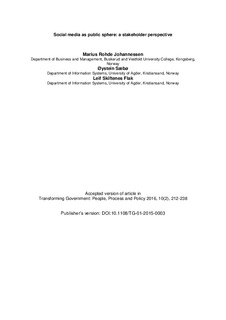| dc.contributor.author | Johannessen, Marius Rohde | |
| dc.contributor.author | Sæbø, Øystein | |
| dc.contributor.author | Flak, Leif Skiftenes | |
| dc.date.accessioned | 2018-02-19T14:07:19Z | |
| dc.date.available | 2018-02-19T14:07:19Z | |
| dc.date.created | 2016-04-14T09:45:04Z | |
| dc.date.issued | 2016 | |
| dc.identifier.citation | Transforming Government: People, Process and Policy. 2016, 10 (2), 212-238. | nb_NO |
| dc.identifier.issn | 1750-6166 | |
| dc.identifier.uri | http://hdl.handle.net/11250/2485735 | |
| dc.description.abstract | Purpose Despite the potential of social media, it has proven difficult to get people actively involved in the decision-making processes. There is a need for more research on how stakeholders manage and use social media to communicate. Thus, we examine major stakeholders’ communication preferences in eParticipation initiatives and discuss how this affects the public sphere. Design/methodology/approach The study was conducted as a qualitative case study. Data sources include interviews, social media content, document analysis and field notes. Findings Communication preferences of stakeholders vary according to their salience level. Stakeholders with higher salience are less likely to participate in social media, while those who are less salient will use every available medium to gain influence. This challenges the opportunity to create a traditional public sphere in social media. Research limitations/implications We contribute to a better understanding of who participates in social media and why. Stakeholder salience analysis shows that in the case of citizen-initiated eParticipation, social media cannot be seen as a Habermasian public sphere. Practical implications We suggest two approaches for government officials’ handling of social media: 1) to treat social media as a channel for input and knowledge about the concerns of citizen groups and 2) to integrate social media in the formal processes of decision making in order to develop consultative statements on specific policy issues. Originality/value Our findings extend current knowledge of the public sphere by adding the stakeholder perspective in addition to existing evaluative models of the public sphere. | nb_NO |
| dc.language.iso | eng | nb_NO |
| dc.title | Social Media as Public Sphere: A Stakeholder Perspective | nb_NO |
| dc.type | Journal article | nb_NO |
| dc.type | Peer reviewed | nb_NO |
| dc.description.version | acceptedVersion | nb_NO |
| dc.source.pagenumber | 212-238 | nb_NO |
| dc.source.volume | 10 | nb_NO |
| dc.source.journal | Transforming Government: People, Process and Policy | nb_NO |
| dc.source.issue | 2 | nb_NO |
| dc.identifier.doi | 10.1108/TG-01-2015-0003 | |
| dc.identifier.cristin | 1350342 | |
| cristin.unitcode | 222,57,4,0 | |
| cristin.unitname | Institutt for økonomi, historie og samfunnsvitenskap | |
| cristin.ispublished | true | |
| cristin.fulltext | postprint | |
| cristin.qualitycode | 1 | |
